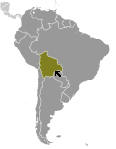World Atlas: Bolivia. On this page you can see the map, country flag and many detailed information about the people, history and economy of Bolivia.

Here you can find online selected information about the geography, inhabitants, government, economy and history of Bolivia. Included are selected statistics, an overview map and the detailed map of Bolivia. But let's start with the flag of Bolivia here:
Bolivia - Overview:
What you should know about Bolivia? Let's start with this: Bolivia, named after independence fighter Simon Bolivar, broke away from Spanish rule in 1825; much of its subsequent history has consisted of a series of coups and countercoups, with the last coup occurring in 1978. Democratic civilian rule was established in 1982, but leaders have faced difficult problems of deep-seated poverty, social unrest, and illegal drug production. In December 2005, Bolivians elected Movement Toward Socialism leader Evo Morales president - by the widest margin of any leader since the restoration of civilian rule in 1982 - after he ran on a promise to change the country's traditional political class and empower the nation's poor, indigenous majority. In December 2009 and October 2014, President Morales easily won reelection. His party maintained control of the legislative branch of the government, which has allowed him to continue his process of change. In February 2016, Morales narrowly lost a referendum to approve a constitutional amendment that would have allowed him to compete in the 2019 presidential election. Despite the loss, Morales has already been chosen by his party to run again in 2019, via a still-undetermined method for him to appear on the ballot.
Geography of Bolivia
 Where on the globe is Bolivia? The location of this country is Central South America, southwest of Brazil. Total area of Bolivia is 1,098,581 sq km, of which 1,083,301 sq km is land. So this is very large country. How could we describe the terrain of the country? This way: rugged Andes Mountains with a highland plateau (Altiplano), hills, lowland plains of the Amazon Basin. The lowest point of Bolivia is Rio Paraguay 90 m, the highest point Nevado Sajama 6,542 m. And the climate is varies with altitude; humid and tropical to cold and semiarid.
Where on the globe is Bolivia? The location of this country is Central South America, southwest of Brazil. Total area of Bolivia is 1,098,581 sq km, of which 1,083,301 sq km is land. So this is very large country. How could we describe the terrain of the country? This way: rugged Andes Mountains with a highland plateau (Altiplano), hills, lowland plains of the Amazon Basin. The lowest point of Bolivia is Rio Paraguay 90 m, the highest point Nevado Sajama 6,542 m. And the climate is varies with altitude; humid and tropical to cold and semiarid.
Inhabitants of Bolivia
Let's take a look how many people live in Bolivia. The number is: 11,138,234 (July 2017 est.). So this is not very populous country. Who lives here? mestizo (mixed white and Amerindian ancestry) 68%, indigenous 20%, white 5%, cholo/chola 2%, black 1%, other 1%, unspecified 3% ; 44% of respondents indicated feeling part of some indigenous group, predominantly Quechua or Aymara. What are the languages in Bolivia? Spanish (official) 60.7%, Quechua (official) 21.2%, Aymara (official) 14.6%, foreign languages 2.4%, Guarani (official) 0.6%, other native languages 0.4%, none 0.1%. And the religions: Roman Catholic 76.8%, Evangelical and Pentecostal 8.1%, Protestant 7.9%, other 1.7%, none 5.5% (2012 est.). How old are the people in average? 24.3 years. We have to add that this number is the median - so one half of the people is older than this, one half is younger. And what is their life expectancy (at birth)? This: 69.5 years. Where the people live in Bolivia? Here: a high altitude plain in the west between two cordillera of the Andes, known as the Altiplano, is the focal area for most of the population; a dense settlement pattern is also found in and around the city of Santa Cruz, located on the eastern side of the Andes. The major urban areas of Bolivia are: Santa Cruz 2.107 million; LA PAZ (capital) 1.816 million; Cochabamba 1.24 million; Sucre (constitutional capital) 372,000 (2015).
Government and Economy of Bolivia
The capital of Bolivia is La Paz (administrative capital); Sucre (constitutional [legislative and judicial] capital) and the government type presidential republic. Let's take a look at the administrative divisions - 9 departments (departamentos, singular - departamento); Beni, Chuquisaca, Cochabamba, La Paz, Oruro, Pando, Potosi, Santa Cruz, Tarija. Regarding the economy of Bolivia, important industrial products are mining, smelting, petroleum, food and beverages, tobacco, handicrafts, clothing, jewelry. Important agricultural products are soybeans, quinoa, Brazil nuts, sugarcane, coffee, corn, rice, potatoes, chia, coca. The most important export commodities are natural gas, silver, zinc, lead, tin, gold, quinoa, soybeans and soy products and the most important export partners are Brazil 19.3%, US 13.6%, Argentina 11.4%, Colombia 8.8%, China 6.8%, Japan 5.9%, South Korea 5.4%, Peru 4.8%, Belgium 4.6% (2016). The most important import commodities are machinery, petroleum products, vehicles, iron and steel, plastics and the most important import partners are China 19.9%, Brazil 17.5%, Argentina 10.5%, US 9.8%, Peru 6.9%, Japan 4.9%, Chile 4.1% (2016). How rich is Bolivia and how rich are people in this country? The most important number here is GDP per capita (PPP): $7,500 (2017 est.). This is quite a low number. Let's add that this means Gross Domestic Product per person, which is recalculated with respect to the relative cost of local goods and services. And one more important number - population below poverty line: 38.6%.